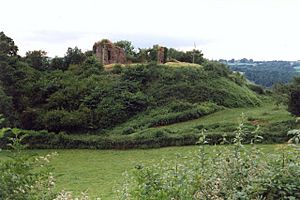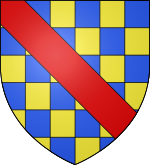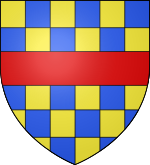Feudal barony of Clifford facts for kids
The feudal barony of Clifford was an important land area in England during the Middle Ages. It was like a large estate or territory controlled by a powerful lord. The main castle and center of this barony was Clifford Castle in Herefordshire, England. This type of barony was a key part of how land and power were organized in medieval England.
Who Owned Clifford Castle?
The de Tony Family
The first records from the Domesday Book in 1086 show that Clifford Castle was held by a man named Ralph de Tony. He was also a powerful lord of another barony called Flamstead in Hertfordshire. Ralph's brother-in-law, William FitzOsbern, 1st Earl of Hereford, had built Clifford Castle. William FitzOsbern was married to Adeliza de Tosny, who was Ralph de Tony's sister.
The de Clifford Family
Sometime before 1127, the barony of Clifford passed to Richard FitzPons. It's not fully clear how this happened. Richard was the brother of Drogo FitzPons, who owned land in Herefordshire. Richard married Maud de Gloucester. Her father was Walter of Gloucester, and her brother was Miles of Gloucester, 1st Earl of Hereford.
Richard FitzPons' son and heir was Walter de Clifford. He was the first to take the surname de Clifford, likely because he was born at Clifford Castle or because it was the name of his father's barony.
Walter de Clifford (who died in 1190) was followed by his son, Richard de Clifford (who died around 1199). Richard had no children, so the barony went to his probable brother, Walter de Clifford (who died in 1221).
The eldest son of this Walter, also named Walter de Clifford (who died in 1263), inherited the barony. However, he had no sons. This meant the barony would pass through his daughter.
Walter de Clifford (who died in 1263) married Margaret, the daughter of Prince Llywelyn ab Iorwerth of Wales. They had a daughter named Maud de Clifford (who died between 1282 and 1285). Maud became the sole heir to the barony.
Maud de Clifford married twice. Her first husband was William Longespée. Her second husband was John Giffard. John Giffard held the barony because of his marriage to Maud. This is called jure uxoris, meaning "by right of his wife."
Maud de Clifford's only daughter, Margaret Longespée (who died between 1306 and 1310), inherited the barony after her stepfather John Giffard died in 1299. Margaret married Henry de Lacy, 3rd Earl of Lincoln.
Margaret Longespée's daughter and only heir was Alice de Lacy (who died in 1348). She married three times but had no children.
Clifford Castle itself was destroyed in 1402. This happened during a rebellion led by Owain Glyndŵr, a Welsh leader.




